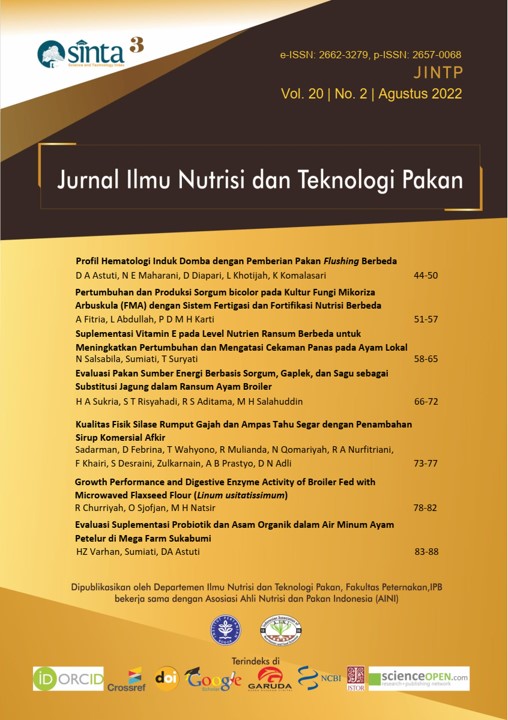Pertumbuhan dan Produksi Sorgum bicolor pada Kultur Fungi Mikoriza Arbuskula (FMA) dengan Sistem Fertigasi dan Fortifikasi Nutrisi Berbeda
Growth and Production of Sorghum bicolor in Arbuscular Mycorrhizal Fungi (AMF) Cultures with Different Fertigation and Nutrient Fortification Systems
Abstract
Arbuscular mycorrhizal Fungi (AMF) is a microorganism that biologically affects plant enzymes and plant nutrients. AMF production development techniques need to be improved with the addition of nutritional fortification to produce quality AMF products. The research aimed was to cultivate AMF with complete fertilizer nutrition and different fertigation systems on Sorghum bicolor. The study used a 2 x 3 factorial randomized design with A factor: fertigation system (flat and terraced) and B factor: fertilizer nutrient levels (1000ppm, 2000ppm, 3000ppm). The results showed that the flat fertigation system had a significant different (p<0.05) on plant height, the number of leaves, stem diameter, and fresh biomass. However, in the high-level fertigation system, numbers of leaf, stem diameter, and fresh biomass did not have significant difference. There was no interaction between the fertigation and nutrient fortification systems. Sorghum panicle age started at 75 yields after planting (DAT). The relationship between percent infection and the number of spores showed a low level of correlation with R2 = 0.032. It can be concluded that the best fertigation system was a flat fertigation system for all nutrient fortifications, with the best average yield on 2000ppm nutrient fortification.
Key words: AMF, fertigation system, nutrition fortification
Downloads
References
Alguacil, M. D. M., Torrecillas, E., Lozano, Z., Torres, M. P., & Roldan, A. 2014. Prunus persica crop management differentially promotes arbuscular mycorrhizal fungi diversity in a tropical agro-ecosystem. PloS one, 9(2), e88454.
Aryanto A T, Karti P D, & Prihantoro I. 2018. Evaluasi produksi dan kualitas inokulum fungi mikoriza arbuskula yang diproduksi dengan teknik hidroponik pada rumput Brachiaria decumbens var. mullato. Jurnal Ilmu Nutrisi dan Teknologi Pakan, 16 (2) :10-19.
Bolan NS. 1991. A critical review on the role of mycorrhizal fungi in the uptake of phosphorus by plants. Plant and soil, 134 (2) :189-207.
Brundrett M, Bougher N, Dell B, Grove T & Malajczuk N. 1996. Working with Mychorrizas In Forestry and Agriculture. Canberra (AU): Australian Centre for International Agricultural Research.
Buwalda JG & Goh KM. 1982. Host-fungus competition for carbon as a cause of growth depressions in vesicular-arbuscular mycorrhizal ryegrass. Soil Biology and Biochemistry 14:103–106.
Ebrahimian H, Keshavarz M R, & Playán E, E. 2014. Surface fertigation: a review, gaps and needs. Spanish Journal of Agricultural Research 12 (3): 820-837
Faye A, Dalpé, Y, Ndung'u-Magiroi, K, Jefwa J, Ndoye I, Diouf, M, & Lesueur D. 2013. Evaluation of commercial arbuscular mycorrhizal inoculants. Canadian Journal of Plant Science, 93(6), 1201-1208.
Friadi R, & Junadhi J. 2019. Sistem kontrol intensitas cahaya, suhu dan kelembaban udara pada greenhouse berbasis raspberry PI. Journal of Technopreneurship and Information System, 2(1), 30-37.
Fortin J A, Bécard G, Declerck S, Dalpé Y, St-Arnaud M, Coughlan AP, & Piché Y. 2002. Arbuscular mycorrhiza on root-organ cultures. Canadian journal of botany, 80(1), 1-20.
Giovannetti M & Mosse B. 1980. An evaluation of techniques for measuring vesicular arbuscular mycorrhizal infection in roots. New Phytologist 84: 489–500.
Guno SR A, Samanhudi S, & Harsono, P. 2021. Kajian penggunaan fungi Mikoriza arbuskular terhadap pertumbuhan dan fisiologis beberapa varietas sorgum di lahan marginal. In Prosiding Seminar Nasional Fakultas Pertanian UNS 5 (1) : 336-344
Hoeman S. 2007. Peluang dan potensi pengembangan sorgum manis. In Makalah Workshop Peluang dan Tantangan Sorgum Manis sebagai Bahan Baku Bioetanol. Jakarta (ID) : Ditjen Perkebunan, Departemen Pertanian
Husein M, Umami N, Pertiwiningrum A, Rahman M. M, & Ananta D. 2022. The role of Arbuscular mycorrhizal fungi density and diversity on the growth and biomass of corn and sorghum forage in trapping culture. Tropical Animal Science Journal, 45(1) : 37-43.
Hutauruk FI, SimanungkalitT, & Irmansyah T. 2012. Pengujian pemberian fungi Mikoriza arbuskula dan pupuk fosfat pada budidaya tanaman sorgum (Sorghum bicolor (L.) Moench). Jurnal Agroekoteknologi Universitas Sumatera Utara, 1(1): 93900
Igiehon NO, & Babalola OO. 2017. Biofertilizers and sustainable agriculture: exploring Arbuscular mycorrhizal fungi. Applied Microbiology and Biotechnology, 101(12): 4871-4881.
Ijdo M, Cranenbrouck S, & Declerck S. 2011. Methods for large-scale production of AM fungi: past, present, and future. Mycorrhiza, 21(1) :1-16.
Karti PD, Astuti DA, & Nofyangtri S. 2012. The role of Arbuscular mycorrhizal fungi in enhancing productivity, nutritional quality, and drought tolerance mechanism of Stylosanthes seabrana. Media Peternakan, 35(1) : 67-67.
Kaur J, Chavana J, Soti P, Racelis A & Kariyat R. 2020. Arbuscular mycorrhizal fungi (AMF) influences growth and insect community dynamics in Sorghum-sudangrass (Sorghum x drummondii). Arthropod-Plant Interactions 14 : 301–315. https://doi.org/10.1007/s11829-020-09747-8
Latef AAHA, Hashem A, RasoolS, Abd_Allah EF, Alqarawi AA, Egamberdieva D & Ahmad P. 2016. Arbuscular mycorrhizal symbiosis and abiotic stress in plants: a review. Journal of plant biology, 59(5) : 407-426.
Lopes JI, Correia CM, GonçalvesA, Silva E, Martins S, Arrobas M, & Rodrigues MÂ. 2021. Arbuscular mycorrhizal fungi inoculation reduced the growth of pre-rooted olive cuttings in a greenhouse. Soil Systems, 5(30.) : 1-14
Lü LH, Zou YN & Wu QS. 2018. Relationship between Arbuscular mycorrhizas and plant growth: Improvement or depression. In: Giri B, Prasad R, Varma A (eds). Root Biology. Soil Biology, vol 52. Springer, Cham. https://doi.org/10.1007/978-3-319-75910-4_18
Marles J, Apriyanto E, & Harsono P. 2018. Respon pertumbuhan dan hasil tiga varietas sorgum di lahan pesisir dengan aplikasi bahan organik dan fungi Mikoriza arbuskular. Naturalis: Jurnal Penelitian Pengelolaan Sumber Daya Alam dan Lingkungan, 7(1) :29-40.
Muryati S, Mansur I, & Budi SW. 2016. Diversity Arbuscular mychorrizal fungi from desmodium spp. PT. Cibaliung Sumberdaya, Banten. Keanekaragaman Fungi Mikoriza Arbuskula (Fma) pada Rhizosfer Desmodium spp. Asal PT. Cibaliung Sumberdaya, Banten. Jurnal Silvikultur Tropika, 7(3) : 188-197.
Napitupulu JP, Irmansyah T, Ginting J, & Ginting J. 2013. Respons pertumbuhan dan produksi sorgum (Sorghum Bicolor (L.) Moench) terhadap pemberian fungi mikoriza arbuskula (Fma) dan kompos kascing. Jurnal Agroekoteknologi Universitas Sumatera Utara, 1(3) : 497 - 510
Omirou M, Fasoula DA, & Ioannides IM. 2016. Bradyrhizobium inoculation alters indigenous AMF community assemblages and interacts positively with AMF inoculum to improve cowpea performance. Applied Soil Ecology, 108 : 381-389. https://doi.org/10.1016/j.apsoil.2016.09.018
Pacioni, G. 1992. Wet Sieving and Decanting Techniques for Extraction of Spores of VA Mycorrhizal Fungi. Methods in Microbiology. Tokyo (JP) :Academic Press Ltd page 317-322.
Pankaj U, Singh G, & Verma R K. 2019. Microbial approaches in management and restoration of marginal lands. New and Future Developments in Microbial Biotechnology and Bioengineering (pp. 295-305).
Panneerselvam P, Kumar U, Sugitha TCK, Parameswaran C, Sahoo S, Binodh AK & Anandan A. 2017. Arbuscular mycorrhizal fungi (AMF) for sustainable rice production. In Advances in Soil Microbiology: Recent Trends and Future Prospects (pp. 99-126)., Singapore (SG) : Springer
Prihantoro I, AFR, & Karti PDMH. 2016. Efektifitas Perbanyakan Kultur Tunggal Cendawan Mikoriza Arbuskula (Gigaspora margarita, Acaulospora tuberculata) Pada Inang Pueraria javanica. Pastura 7 (1) : 1-3
Pozo MJ, López-Ráez JA, Azcón-Aguilar C & Garrido JMG. 2015. Phytohormones as integrators of environmental signals in the regulation of mycorrhizal symbiose. New Phytologist. 205 (4):1431–1436. https://doi.org/10.1111/nph.13252
Rini MV, & Rozalinda V. 2020. Pengaruh tanaman inang dan media tanam pada produksi fungi mikoriza arbuskular. Jurnal Agrotropika, 15(1) : 37-41
Salem A P, Hastuti PB & Rusmarini UK. 2016. Pengaruh perbedaan jenis tanah (regosol dan latosol) dan aplikasi pupuk organik terhadap bibit kelapa sawit. Jurnal Agromast, 1(2) : 1-11
Sharma S, Sharma S, Aggarwal, A, Sharma V, Singh, M J, & Kaushik S. 2017. Mass Multiplication of Arbuscular Mycorrhizal Fungi. Mycorrhizal Fungi. Page 154-173
Suminarti NE. (2019). Dampak pemupukan N dan zeolite pada pertumbuhan serta hasil tanaman sorghum (Sorghum bicolour L.) Var. SUPER 1. Jurnal Agro, 6(1), 1-14 https://doi.org/10.15575/3932
White JA & Charvat I. 1999. The mycorrhizal status of an emergent aquatic, Lythrum salicaria L., at different levels of phosphorus availability. Mycorrhiza, 9(4): 191-197.
Yassir I & Budi SW. 2007. Potensi dan Status Cendawan Mikoriza Arbuskula (CMA) pada Lahan Kritis di Samboja, Kalimantan Timur. Info Hutan 4(2) : 139-151.
Copyright (c) 2022 A Fitria, L Abdullah, P D M H Karti

This work is licensed under a Creative Commons Attribution 4.0 International License.
The authors of the submitted manuscript have to understand and agree that the copyrights published are held by Jurnal Ilmu Nutrisi dan Teknologi Pakan. Copyrights includes rights in reproducing, distributing and selling every section of articles in all forms and media. The copyright transfer form is signed by the corresponding author. The author”
• Creative Commons Attribution (CC BY)
you are allowed to:
Share – copy and redistribute the material in any medium or format
Adapt – remix, transform, and build upon the material
for any purpose, even commercially.
The licensor cannot revoke these freedoms as long as you follow the license terms.
Jurnal Ilmu Nutrisi dan Teknologi Pakan (Nutrition and Feed Technology Journal)

This work is licensed under a Creative Commons Attribution 4.0 International License.












